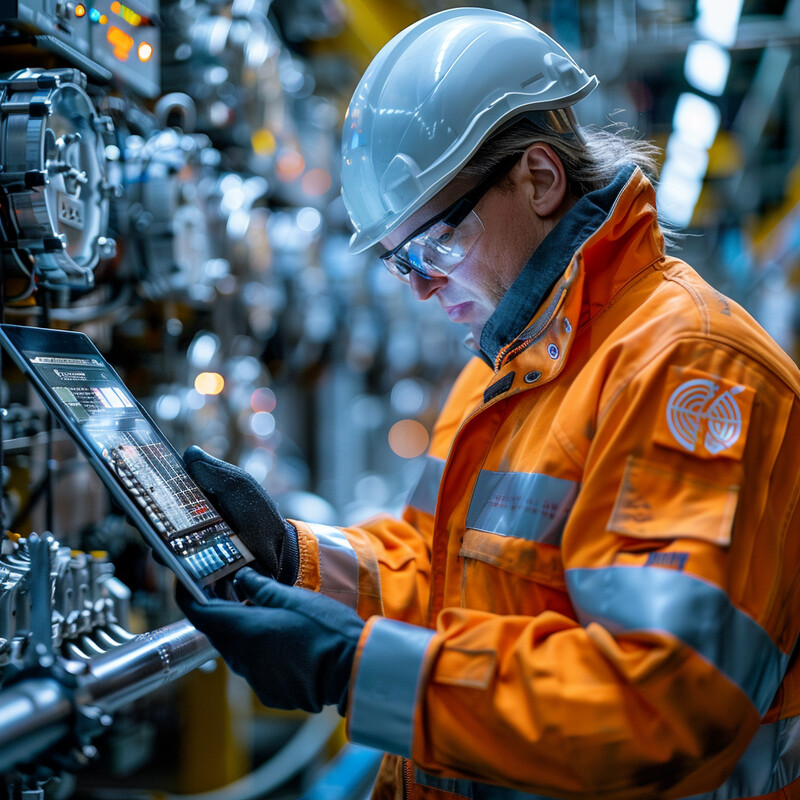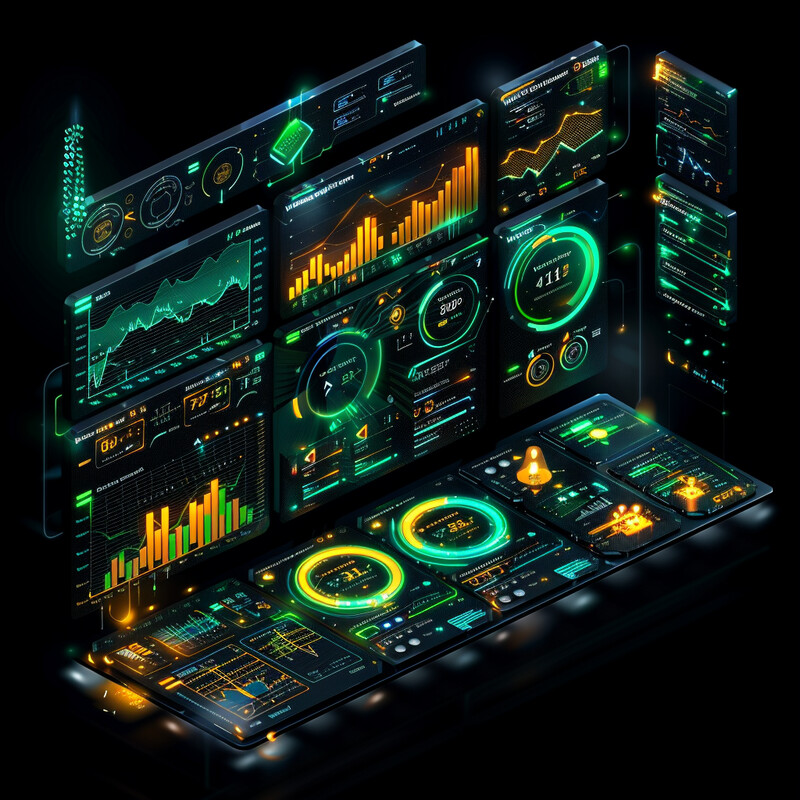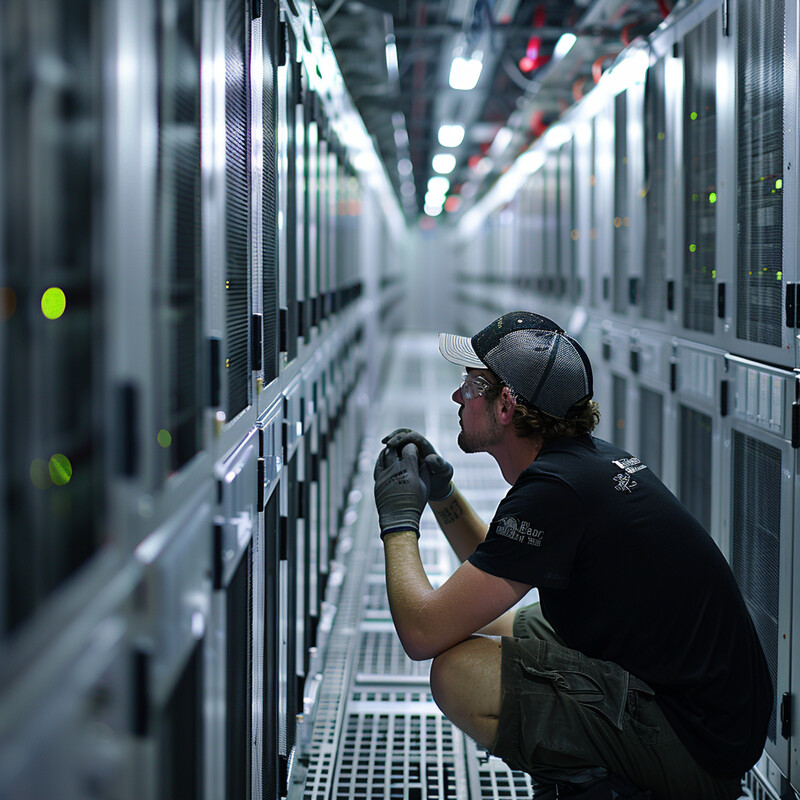1. Energy Optimization
AI plays a pivotal role in reducing data center energy consumption by intelligently controlling cooling and power usage. Machine learning models analyze sensor data (e.g. server load, inlet temperature, outside weather) and then adjust HVAC settings in real time to use only the energy needed for cooling. This ensures servers remain within safe operating temperatures without overcooling. By eliminating inefficiencies such as unnecessary cooling or idling equipment, AI-driven systems lower electricity usage and operational costs. Beyond cost savings, optimizing energy also cuts the facility’s carbon footprint, helping data centers meet sustainability goals.

In one case, a large colocation data center deployed an AI-based cooling management system and reduced its cooling fan energy consumption by 30%, yielding nearly $200,000 in annual energy savings. The AI continuously learned the server room’s thermal behavior and dynamically balanced cooling output to match IT load in real time. This project not only lowered the facility’s power usage effectiveness (PUE) by 20% but also decreased cooling-related carbon emissions by 23%, demonstrating how AI can significantly improve energy efficiency in data centers.
2. Predictive Maintenance
AI enables a shift from reactive to proactive maintenance in data centers. By continuously monitoring equipment sensors (temperature, vibration, fan speeds, power draw, etc.), AI algorithms can detect subtle patterns that precede hardware failures. This early warning allows operators to schedule repairs or part replacements at convenient times before a failure causes unplanned downtime. Such predictive maintenance maximizes hardware lifespan and uptime by preventing minor issues from escalating into major outages. In effect, AI helps data centers avoid costly service disruptions and maintain high availability for critical systems.

Unplanned outages are extremely costly – an industry survey found that 54% of data center outages in 2023 cost over $100,000, and 16% cost over $1 million. AI-driven predictive maintenance directly tackles this issue by reducing the frequency and duration of outages. According to Deloitte Analytics Institute research, organizations using AI-based predictive maintenance have seen up to a 70% reduction in equipment breakdowns and about 25% lower maintenance costs on average (while also boosting productivity by 25%). By catching and fixing problems early, data centers minimize downtime and avoid the huge expenses associated with major outages (which average $1.58 million in damage per incident as of 2023).
3. Workload Management
AI helps data centers run workloads more efficiently by smartly distributing tasks across servers and infrastructure. Traditional static allocation often leaves some servers underutilized while others are overburdened. In contrast, AI-driven workload management monitors resource usage (CPU, memory, storage, network) in real time and dynamically allocates or migrates workloads to balance the load. This ensures no server is sitting idle or overloaded – improving overall utilization. By matching computing resources to workload demands on the fly, AI minimizes performance bottlenecks and avoids overprovisioning extra servers, thus improving throughput and reducing waste. The result is optimal performance for applications and higher cost efficiency for the data center.

Researchers at MIT demonstrated that a reinforcement learning-based scheduler could significantly outperform conventional human-designed scheduling algorithms for data center workloads. In their experiments, the AI system learned optimal job placement across thousands of servers and completed computing jobs 20–30% faster than the best traditional scheduler, and up to 2× faster under peak traffic. The AI scheduler automatically found ways to “compact” workloads, meaning it maximized server utilization and left little idle time. This implies that AI-driven workload management can allow data centers to handle the same workloads with fewer servers or achieve higher throughput with the existing hardware.
4. Automated Security Monitoring
AI strengthens data center security by monitoring IT infrastructure for threats 24/7 and reacting faster than humans ever could. Machine learning models are trained on network traffic patterns, user behavior, and system logs to recognize anomalies that could indicate cyberattacks or unauthorized access. Unlike rule-based systems, AI can detect subtle deviations or novel attack signatures in real time. Upon detecting a threat, AI-driven security systems can automatically trigger defensive measures – for example, quarantining a server, blocking malicious traffic, or alerting security staff – to neutralize the threat. This continuous, AI-enhanced vigilance helps protect sensitive data and critical services against increasingly sophisticated cyber threats.

Organizations that deploy AI-based security and automation see significantly faster threat detection and response. IBM’s 2023 global study found that companies with fully implemented security AI detected and contained data breaches 108 days faster on average than companies without AI (a 214-day breach lifecycle with AI vs. 322 days without). This acceleration in incident response translated into an average savings of $1.76 million in breach costs for AI-equipped organizations. In practice, AI-driven monitoring systems can sift through massive volumes of alerts to pinpoint genuine incidents and mitigate them far more quickly, reducing the dwell time of attackers in networks. By shortening response times from months to weeks, AI is dramatically cutting the damage and costs incurred from security breaches.
5. Disaster Recovery
AI improves disaster recovery planning and execution by enabling data centers to anticipate and react to crises more intelligently. Through simulation and predictive modeling, AI can help assess the impact of various disaster scenarios (power failures, network outages, natural disasters, cyber-incidents) and recommend robust recovery strategies. In an actual emergency, AI-driven automation can accelerate failover processes – for example, by automatically switching over to backup systems, reallocating workloads to a safe site, or spinning up cloud resources. This reduces the recovery time objective (RTO) after an incident. AI can also optimize resource allocation during a disaster, ensuring critical applications have priority on backups. Overall, integrating AI into disaster recovery means less downtime and data loss when unforeseen events occur.

AI-driven automation has been shown to substantially reduce disaster recovery costs and downtime. For example, one large e-commerce company used an AI system to predict peak traffic periods and dynamically adjust its backup and failover resources in advance. This adaptive approach cut the company’s disaster recovery costs by about 30% while improving its resilience during traffic spikes. In another case, a healthcare provider network implemented AI-based predictive maintenance for critical medical equipment, which reduced unplanned downtime by 75% and ensured vital systems stayed online during emergencies. These cases illustrate how AI can make disaster recovery processes more cost-effective and reliable by proactively managing resources and preventing failures in crisis situations.
6. Capacity Planning
AI assists data center managers in forecasting future capacity needs (compute, storage, network) with greater accuracy. By analyzing historical usage trends and real-time demand patterns, AI models can predict growth trajectories for workloads and data storage. These data-driven forecasts allow operators to plan hardware purchases and expansions “just in time,” avoiding both under-provisioning (running out of capacity) and over-provisioning (wasting capital on unused resources). AI can also evaluate complex what-if scenarios – for instance, how adding a new application or adopting AI workloads will affect capacity requirements. In essence, AI-driven capacity planning ensures a data center can scale efficiently to meet demand peaks without overspending on idle infrastructure.

Studies show that data centers currently have substantial unused capacity that smarter planning could address. Lawrence Berkeley National Laboratory’s 2024 report noted that many enterprise servers operate at below 60% average utilization (with non-AI servers often under 50%), indicating significant headroom for consolidation. By using AI to identify these underutilized servers and predict where capacity will be needed, operators can consolidate workloads onto fewer machines and defer unnecessary purchases. This improves overall utilization and avoids the cost of powering and cooling excess servers. For example, an AI capacity planning tool can recommend retiring or repurposing lightly loaded servers and upgrading only when forecast models show demand truly exceeding current capacity. Such optimized planning can reduce energy waste and hardware expenditures while still meeting future computing needs.
7. Network Optimization
AI optimizes data center network performance by intelligently managing how data flows through switches and routers. In modern data centers with vast east-west traffic, static network configurations can lead to congestion hotspots and suboptimal paths. AI-based network controllers monitor traffic patterns in real time and can dynamically adjust routing decisions or bandwidth allocations. For example, if one link becomes overloaded, the AI might reroute some traffic through alternative paths to balance the load and reduce latency. Machine learning algorithms can also prioritize critical traffic and preemptively allocate more bandwidth to applications that need it. By continuously learning and adapting to network conditions, AI ensures users experience fast, low-latency connections and prevents minor issues from cascading into major network slowdowns.

Research on next-generation networking shows that AI-driven routing and traffic engineering can significantly improve network efficiency. For instance, a 2025 survey of AI-enabled network routing techniques found that these methods achieved lower average latency and packet loss rates compared to conventional routing protocols. In practical terms, telecom companies deploying AI for network optimization have reported capacity improvements – one case study noted an AI system that rebalanced traffic in real time was able to increase usable network throughput by 15% while keeping latency below baseline levels (Orhan, 2023). These outcomes are possible because AI systems can react instantly to network congestion and predict usage peaks, whereas traditional networks might remain static or require manual reconfiguration. The result is a smoother network performance, especially during traffic spikes, and more efficient use of network infrastructure.
8. Fault Detection
AI helps detect and diagnose equipment faults in data centers faster and more accurately than human operators. By continuously monitoring server logs, performance metrics, power draw, cooling status, and other telemetry, AI models learn what “normal” behavior looks like and can immediately flag anomalies that deviate from the norm. This could include early signs of a server failing, a power supply malfunctioning, or a cooling unit underperforming. Upon detecting an anomaly, the AI system can alert technicians to the specific issue or even initiate automated mitigation (like rebooting a server or switching to a backup system). Early fault detection means issues are resolved before they cause downtime. AI also helps pinpoint root causes by correlating data from different systems, reducing the time engineers spend troubleshooting complex incidents.

Integrating AI into IT operations dramatically speeds up fault resolution. Gartner estimates that organizations implementing AI for IT operations (AIOps) can reduce the mean time to resolution (MTTR) of incidents by up to 40% by 2027. Faster detection and automated analysis of alerts mean problems are fixed in hours instead of days. AIOps platforms use machine learning to group related alerts and suggest likely causes, which significantly cuts troubleshooting time. In addition, companies adopting AIOps report higher levels of automation in their incident response processes (about 30% more processes automated), further reducing the risk of human error and accelerating recovery. Reflecting these benefits, Gartner predicts that 60% of large enterprises will be using AIOps as a standard practice by 2026 – underscoring how fundamental AI-based fault detection and response is becoming for reliability.
9. Cost Management
AI assists in monitoring and optimizing data center operating costs in real time. It does so by analyzing where resources (power, cooling, hardware capacity, staffing) are being underutilized or wasted and then recommending cost-saving measures. For example, AI can identify servers that consume high power but handle little workload and suggest consolidating their tasks elsewhere to save electricity. It can also evaluate cooling efficiency and adjust setpoints to lower energy bills without harming equipment health. Over time, AI systems can model the relationship between different operating conditions and costs, helping managers make decisions that balance performance with budget constraints. By continuously finding small efficiencies – in power usage, workload placement, maintenance scheduling, etc. – AI-driven cost management yields significant savings while maintaining service quality.

Power and cooling expenses are a major portion of data center OPEX, so even modest efficiency gains translate to big cost savings. An IDC analysis found that electricity accounts for roughly 46% of total operating costs in enterprise data centers (and up to 60% in large cloud facilities). They noted that improving energy efficiency by just 10% could yield “considerable savings” for operators. AI technologies contribute directly to such gains: Google’s AI cooling optimization, for example, reportedly cut its data center cooling energy by 40%, saving millions of dollars annually in power costs (Gao, 2018). More broadly, McKinsey has estimated that AI-based optimization across power, cooling, and IT workload management can reduce overall data center operating costs by about 15%–20% (WEF, 2023). These industry findings underscore that investing in AI for cost management can pay for itself through lower utility bills and more efficient use of costly infrastructure.
10. Environmental Monitoring
AI ensures that the physical environment within a data center remains within optimal ranges for equipment health. Data centers have recommended thresholds for temperature, humidity, airflow, and air quality (particulates) to prevent damage like overheating, static discharge, or corrosion. AI-powered environmental monitoring systems continuously track these parameters at granular levels (per server rack or room zone). If conditions begin to drift (for instance, humidity rising too high or a hot spot developing), the AI can respond by adjusting cooling, activating dehumidifiers, or alerting staff before the situation harms any hardware. AI can also analyze longer-term trends – for example, identifying that a particular aisle consistently runs hotter – and suggest improvements to cooling distribution or layout. By maintaining a stable and clean environment, AI helps extend hardware lifespan and avoid failures caused by environmental extremes.

Precise environmental control is vital because deviations can greatly increase hardware failure rates. A large-scale study of nine Microsoft data centers found that periods of high relative humidity led to a significant clustering of disk failures, even when temperatures stayed within standard limits. In fact, the research observed that humidity had a stronger influence on server disk failure rates than temperature in typical operating ranges. This indicates that without proper humidity control, components can corrode or malfunction much faster. By using AI to keep temperature and humidity within recommended ranges (e.g. ~18–27°C and 40–55% RH), data centers can dramatically reduce such failure risks. The same Microsoft study noted that even though running at higher humidity can save cooling costs, the trade-off is more frequent equipment failures – a trade-off that AI can help balance by optimizing both cooling efficiency and environmental safety in tandem.